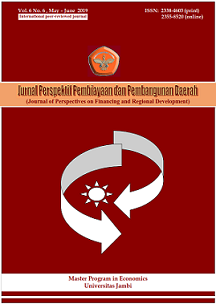Non-linear return to human capital for workers of productive sectors in Indonesia
DOI:
https://doi.org/10.22437/ppd.v6i6.6710Abstract
This study is aimed to investigate a typical return to human capital for workers of productive economic sectors in Indonesia. Instead of satisfying Mincer’s linearity assumption, we use a piecewise linear spline function in order to trace marginal returns to education and job tenure and to find out how large the returns to both variables could be moderated by certain variables. The research is conducted on 2609 individuals who work for Indonesian top-five productive sectors in 2016, as recorded in National Work Force Survey (SAKERNAS). We implement quantile regression analysis to produce three levels earning model. The result shows that the return to education varies across schooling level and apparently negative for academy schooling. We also find that job training participation does not always enhance the return to education especially for higher earning workers. The return to job tenure is found to diminish during career length. However, graduating from certain college majors significantly slowdown the diminishing return to job tenure and thus promoting better career. Based on these findings, we outline several ideas concerned to developing higher education and job training provision in national scale for more efficient supply of human capital in the productive sectors.
Downloads
References
Adrimas. (2004). Pertumbuhan Ekonomi dan Pengangguran Terdidik di Sumatera Barat. Thesis, Universiti Sains Malaysia.
Akguç. M (2011). The Effects of Different Stages of Education on Income Across Countries. Thesis, Toulouse School of Economics. Retrieved October 21, 2018 fromhttp://iredu.u-bourgogne.fr/images/stories/Documents/Textes_seminaires_ iredu/sem090310.pdf
Badan Pusat Statistik. (2016). Keadaan Angkatan Kerja di Indonesia Agustus 2016. Jakarta: BPS
Badan Pusat Statistik. (2017). Laporan Perekonomian Indonesia 2017. Jakarta: BPS
Badan Pusat Statistik. (2017). Statistik Indonesia 2017. Jakarta: BPS
Becker, G.S. (1962). Investment in Human Capital: A Theoritical Analysis. The Journal of Political Economy, 70(5), 9 – 49
Becker, G.S. (1992). Human Capital: A Theoritical and Empirical Analysis with Special Reference to Education, 2nd edition. Chicago: The University of Chicago Press
Brunello, G. & Rocco, L. (2015). The Effects of Vocational Education on Adult Skills and Wages: What Can We Learn From PIAAC?. Working Papers, No. 168. Paris: OECD Publishing
Cho, S., Kam, J. & Lee, S. (2017). Efficient Supply of Human Capital: Role of College Major. Discussion Paper No. 10610, IZA
Elfindri & Bachtiar, N. (2004). Ekonomi Ketenagakerjaan. Padang: Andalas University Press.
Fahmy, R., Bachtiar, N., & Sari, D.T. (2016). The Effect of Human Capital on Earning of Indonesian Migrant Workers from West Sumatera in Malaysia. International Journal of Economics Research, 13(5), 2297 – 2311
Fouarge, D., Schils, T. & de Grip, A. (2010). Why Do Low-Educated Workers Invest Less in Further Training?. Discussion Paper No. 5180, IZA
Heckman, J.J., Lochner, L.J. & Todd, P.E. (2003). Fifty Years of Mincer Earnings Regressions, Working Paper No. 9732. New York: National Beaurau of Economic Research
Kadir, S., Nirwansyah & Bachrul, B.A. (2016). Technical and Vocational Education and Training in Indonesia: Challenges and Opportunities for the Future. Singapore: Lee Kuan Yew School of Public Policy.
Kim, S. & Mohtadi, H. (1992). Education, Job Signaling, and Dual Labor Markets in Developing Countries. Bulletin 7503, Economic Development Center University of Minnesota
Koenker, R. & Machado, J.A.F. (1999). Goodness of Fit and Related Inference Processes for Quantile Regression. Journal of American Statistics Association. 94(448), 1296 – 1310
Lynch, L.M. (1992), Private Sector Training and the Earning of Young Workers. American Economic Review, 82(1), 299 – 312
Lusia, A. & Amelia, D. (2018). The Vocational Education Branding: Lessons Learned from Indonesian Academic-Industry Relationship. Conference Paper, The 2nd International Conference on Vocational Higher Education (ICVHE) 2017
Magdalyn, A. (2013). The Rate of Return to Education: the Case of Indonesia. Thesis, International Institute of Social Studies, Hague
Mincer, J. (1974). Schooling, Experience and Earnings. New York: National Bureau of Economic Research
Purnastuti, L., Wahyuni, D. & Mustofa (2015). Analisis Tingkat Pengembalian Investasi Pendidikan di Daerah Istimewa Yogyakarta. Paper. Seminar Nasional Asosiasi Profesi Pendidik Ekonomi Indonesia, Universitas Negeri Yogyakarta, 9 May
Purnastuti, L., Miller, P. & Salim, R. (2011), Economic returns to schooling in a less developed country: evidence for Indonesia, International Conference on Applied Economics (ICOAE), 495 – 501
Saidah, Yanuar, F., & Devianto, D. (2017). Analisis Regresi Kuantil, Jurnal Matematika UNAND, 5(1), 103–107
Saraswati, E. (2012). Public Spending Education and Inequality: A Case Study in Indonesia. International Journal of Social Science and Humanity. 2(5), 427 – 431
Schady, N.R. (2003). Convexity and Sheepskin Effects in the Human Capital Earnings Function: Recent Evidence for Filipino Men. Oxford Bulletin of Economics and Statistics, 65(2), 171–196
Schultz, T.W. (1961). Investment in Human Capital. The American Economic Review, 51(1), 1-17
Smith, W.J. (2001). Estimates of the Effects of Education and Training on Earnings. Fiscal Research Program Report No 54. Atlanta: Andrew Young School of Public Policies, Georgia State University, Retrieved October 25, 2018 from http://cslf.gsu.edu/files/2014/06/estimates_of_the_effects_of_education_and_training_on_earnings.pdf
Söderbom, M., Teal, F., Wambugu, A., & Kahyarara, G. (2006). The dynamics of returns to education in Kenyan and Tanzanian manufacturing, Oxford Bulletin of Economics and Statistics, 68(3), 261-288.
Skjaerlund, G. & van der Loop, T. (2015). Supply of non-formal training in Indonesia, Working paper no. 23, Tim Nasional Percerpatan Penanggulangan Kemiskinan (TNP2K)
Suhardan, D., Riduwan & Enas. (2012). Ekonomi dan Pembiayaan Pendidikan. Bandung: Alfabeta
Trostel, P.A. (2005). Nonlinearity in the return to education. Journal of Applied Economics, 8(2), 191-202
van Dam, N.H.M. (2017). The 4th Industrial Revolution and the Future of Jobs. Bookboon. Retrieved October 13, 2018 from https://bookboon.com/en/the-4th-industrial-revolution-the-future-of-jobs-ebook
Wahyuni, R.N.T & Monika, A.K. (2016). Pengaruh Pendidikan Terhadap Ketimpangan Pendapatan Tenaga Kerja di Indonesia. Jurnal Kependudukan Indonesia, 11(1), 15 – 28
Wilson, R.A., & Briscoe, G. (2004). The impact of human capital on economic growth: a review. Impact of education and training, Third report on vocational training research in Europe. Luxembourg: EUR-OP. Retrieved October 11, 2018 from
http://www.warwick.ac.uk/fac/soc/ier/publications/2003/wilson_and_briscoe_2003.pdf
Downloads
Published
How to Cite
Issue
Section
License
Copyright (c) 2019 Fajar Wisga Permana, Nasri Bachtiar, Adrimas Adrimas

This work is licensed under a Creative Commons Attribution 4.0 International License.

















